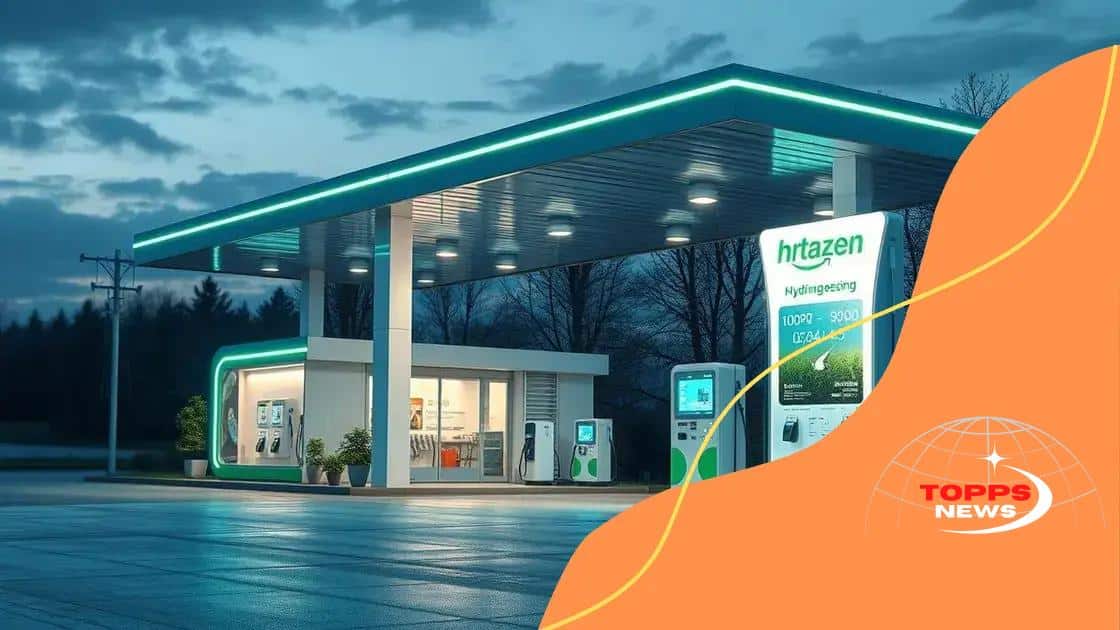Advances in green hydrogen technology are transforming energy

Advances in green hydrogen technology enable a cleaner energy future by reducing emissions, improving efficiency, and promoting sustainable applications across various industries, including transportation and energy storage.
Advances in green hydrogen technology are reshaping our energy landscape, offering a sustainable alternative to fossil fuels. Have you ever wondered how this technology could impact your daily life?
Understanding green hydrogen technology
Understanding green hydrogen technology is essential for grasping its role in our future energy landscape. This innovative approach offers a cleaner alternative to traditional fuels, harnessing renewable energy sources. Green hydrogen is produced through a method called electrolysis, where water is split into hydrogen and oxygen. By using electricity from renewable sources like wind and solar, we can create hydrogen without emitting carbon.
What Makes Green Hydrogen Sustainable?
The sustainability of green hydrogen lies in its production process. Unlike fossil fuels, which release greenhouse gases, green hydrogen is generated in a way that prioritizes environmental health. This process contributes to reducing carbon footprints and encourages energy independence.
Key Advantages of Green Hydrogen
- Reduces carbon emissions significantly.
- Utilizes abundant renewable resources.
- Can be stored and transported easily.
- Supports energy diversification and security.
As technology continues to advance, green hydrogen plays a crucial role in large-scale energy systems. It can be stored and used in various applications, such as fuel cells for vehicles, heating, and even electricity generation. The versatility of green hydrogen makes it a key player in achieving energy goals.
Moreover, many nations are investing heavily in green hydrogen projects. By fostering collaboration between governments, industries, and research institutions, we can accelerate the transition towards a more sustainable energy future. With ongoing research and development, the potentials of green hydrogen seem limitless.
Key advancements in green hydrogen
Key advancements in green hydrogen technology are shaping the future of energy. These innovations enhance efficiency, reduce costs, and promote the use of renewable resources. Recently, breakthroughs in electrolysis are making it easier to produce hydrogen more sustainably. These improvements allow for greater energy conversion rates, which mean more hydrogen can be produced using less electricity.
Innovative Electrolysis Techniques
One of the notable advancements is the development of new electrolyzers that utilize advanced materials. These materials increase efficiency and durability, making the process of hydrogen production faster and more reliable.
- Enhanced catalytic materials for faster reactions.
- Membranes that minimize energy loss.
- Scalable designs for larger production capacities.
Alongside electrolysis, significant progress is made in the storage and transport of green hydrogen. Innovations in storage tanks and transportation methods are allowing hydrogen to be stored more safely and efficiently. This ensures that when we produce hydrogen, we can easily deliver it to where it’s needed.
Moreover, integration with renewable energy systems enhances the overall sustainability of hydrogen projects. The ability to harness surplus energy from solar and wind sources makes green hydrogen even more attractive. This ensures production is not only efficient but also eco-friendly.
Collaboration and Investment Trends
Another key factor in recent advancements is increased collaboration among governments, private companies, and research institutions. These partnerships are crucial for accelerating the development of green hydrogen technologies. With growing investment in research and deployment, we are witnessing lower costs and broader adoption.
- Public support for green technology initiatives.
- Private investments in hydrogen infrastructure.
- Research grants for innovative projects.
As the industry progresses, innovations in green hydrogen not only drive down costs but also stimulate job creation in new sectors. By fostering a clean energy transition, these advancements are helping to create a better environment for future generations.
Applications of green hydrogen in industry

The applications of green hydrogen in industry are vast and varied, making it a pivotal player in the transition to sustainable energy. Industries are using green hydrogen for several purposes that highlight its versatility and environmental benefits. By replacing fossil fuels with hydrogen, businesses can significantly reduce their carbon emissions and enhance sustainability.
Fuel for Transportation
One of the most promising applications is in the transportation sector. Green hydrogen can power fuel cell vehicles, providing a clean alternative to traditional gasoline and diesel engines. This shift not only reduces air pollution but also decreases dependence on fossil fuels.
- Heavy-duty trucks and buses utilizing hydrogen fuel cells.
- Hydrogen-powered trains for efficient, low-emission transport.
- Marine vessels using hydrogen to reduce their carbon footprint.
In addition to transportation, green hydrogen is key in various industrial processes. For example, it’s used in the production of ammonia, a vital ingredient for fertilizers. By adopting green hydrogen, the ammonia industry can shift towards a more sustainable model, minimizing greenhouse gas emissions.
Energy Storage Solutions
Another significant application of green hydrogen is its role in energy storage. It can be used to stabilize energy grids by storing excess energy produced from renewable sources. This ensures that energy is available when demand is high, effectively balancing supply and demand.
- Hydrogen can be stored in large quantities for later use.
- It can convert excess electricity into hydrogen when renewable energy outputs are high.
- Stored hydrogen can be converted back to electricity when needed.
Furthermore, green hydrogen is making strides in the steel and chemical industries. By employing hydrogen in production processes, companies can achieve lower emissions compared to traditional methods. This transition is crucial for achieving global climate targets.
As industries continue to explore and implement these applications, the demand for green hydrogen is expected to rise. Businesses are increasingly prioritizing sustainability, and adopting green hydrogen is a significant step towards achieving that goal.
Challenges faced by green hydrogen technology
Challenges faced by green hydrogen technology are critical to understand as the world transitions to cleaner energy sources. Although this technology holds great promise, several hurdles must be overcome to ensure its widespread adoption and effectiveness. One of the main challenges is production costs, which can be high compared to traditional fossil fuels. Developing efficient electrolysis methods can help bring these costs down.
Infrastructure Development
In addition to production costs, the need for infrastructure is significant. Existing systems were designed around fossil fuels, making it difficult to integrate green hydrogen into the current energy landscape. Building new hydrogen production, storage, and transport facilities will require substantial investment and planning.
- Upgrading pipelines for hydrogen transport.
- Creating storage facilities that can handle hydrogen safely.
- Establishing fueling stations for hydrogen-powered vehicles.
Another challenge is public perception and understanding of green hydrogen. Many people are still unaware of its benefits and potential applications. This lack of knowledge can hinder policy support and investment needed to expand hydrogen technologies. Educating the public and industries will be essential to overcoming resistance against adopting this technology.
Efficiency and Scale
Moreover, scaling up production and improving efficiency are ongoing challenges. As demand for green hydrogen rises, the need for scalable technologies that can produce large quantities at lower costs becomes crucial. Developing more effective electrolyzers and leveraging renewable energy sources will be necessary to meet future demands.
- Researching new materials for better electrolyzers.
- Enhancing system integration with renewable sources.
- Improving energy conversion rates in hydrogen production.
Finally, competition from other clean energy technologies poses a challenge. Renewable energy sources like solar and wind are becoming more affordable and widely implemented. While green hydrogen is a valuable option, it must compete with these other technologies to gain market share. Addressing these challenges will be essential in paving the way for a sustainable hydrogen economy.
The future of green hydrogen energy
The future of green hydrogen energy is bright and full of potential. With growing concerns about climate change, green hydrogen stands out as an effective solution for reducing greenhouse gas emissions. As governments and industries begin to prioritize sustainability, the demand for hydrogen as a clean energy source is expected to grow exponentially.
Market Growth Opportunities
Many experts predict significant market growth for green hydrogen in the coming years. Expansion will likely occur in various sectors, including transportation, manufacturing, and energy. Businesses are increasingly recognizing the value of adopting green hydrogen technologies to enhance their operations and meet environmental standards.
- Increasing investment in hydrogen infrastructure.
- Collaboration between public and private sectors.
- Global initiatives promoting hydrogen adoption.
In addition, the integration of green hydrogen into existing energy systems is becoming more feasible. As renewable energy technologies advance, it is easier to produce green hydrogen at lower costs. This enhances its appeal as an alternative energy source compared to traditional fossil fuels.
Technological Advancements
Technological advancements will play a crucial role in the future of green hydrogen. Continuous research is focusing on improving efficiency in production, storage, and distribution. New electrolysis methods are being developed to create hydrogen more effectively and sustainably.
- Innovations in electrolyzer technology to lower costs.
- Enhanced storage solutions for better safety and efficiency.
- Improvements in transportation logistics for hydrogen delivery.
Moreover, the potential for hydrogen in energy storage systems is gaining attention. As countries work toward decarbonization goals, green hydrogen can act as a buffer, storing excess renewable energy for later use. This capability makes it a vital player in balancing energy supply and demand.
With the global shift towards cleaner energy solutions, the role of green hydrogen is expected to expand even further. Numerous nations are pledging to increase their investment in green technologies, showcasing a commitment to building a sustainable future. The journey toward a hydrogen economy is underway, and it promises to reshape energy systems worldwide.
FAQ – Frequently Asked Questions about Green Hydrogen Energy
What is green hydrogen?
Green hydrogen is produced using renewable energy sources, making it a clean alternative to fossil fuels. It helps reduce carbon emissions.
How is green hydrogen produced?
Green hydrogen is produced through a process called electrolysis, which splits water into hydrogen and oxygen using electricity from renewable sources.
What are the main applications of green hydrogen?
Green hydrogen can be used in transportation, energy storage, and industrial processes like ammonia production, contributing to a cleaner environment.
What challenges does green hydrogen technology face?
The main challenges include high production costs, the need for infrastructure development, and competition from other clean energy technologies.





